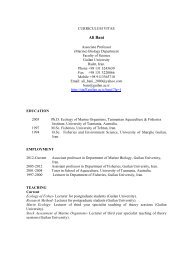Medical Tourism in Developing Countries
Medical Tourism in Developing Countries
Medical Tourism in Developing Countries
- No tags were found...
Create successful ePaper yourself
Turn your PDF publications into a flip-book with our unique Google optimized e-Paper software.
Promot<strong>in</strong>g <strong>Medical</strong> <strong>Tourism</strong> ● 161diversify <strong>in</strong>to the production of other goods and services more suited totheir conditions. A similar shift <strong>in</strong> the spatial location of medical servicesupply has occurred. Several decades ago, American hospitals such as theMayo Cl<strong>in</strong>ic drew patients from across the world. While the United Statesrema<strong>in</strong>s attractive to <strong>in</strong>ternational patients for specialized procedures, 83 theforeign demand is shift<strong>in</strong>g towards lower-cost providers across the world.In addition, domestic consumers <strong>in</strong> Western countries are f<strong>in</strong>d<strong>in</strong>g it costeffectiveto travel to develop<strong>in</strong>g countries. Where does that leave sites suchas the Mayo Cl<strong>in</strong>ic? While it still draws <strong>in</strong>ternational patients for sophisticatedand complicated medical procedures, it has had to reorient its servicesto respond to the chang<strong>in</strong>g overall composition of its patients (for example,along with many hospitals across the United States, the Mayo Cl<strong>in</strong>ic nowprovides luxury health care for Americans, also known as concierge orboutique services 84 ).Ironically, the economic reality of shift<strong>in</strong>g production locations meansthat the ten countries under study are likely to lose their advantage <strong>in</strong> theproduction of medical tourism as they develop and their production costs<strong>in</strong>crease (as Gary Becker noted, when they no longer have the comparativeadvantage, the supply locus of medical tourism will move elsewhere 85 ).It also has implications for Western medic<strong>in</strong>e that needs to deal with notonly the loss of <strong>in</strong>ternational patients but, more importantly, the loss ofdomestic patients as they seek lower-cost care across the world.Bottom l<strong>in</strong>e: With globalization, the spatial location of production isshift<strong>in</strong>g more rapidly than it did <strong>in</strong> the past, and comparative advantages<strong>in</strong> the provision of medical care are not set <strong>in</strong> stone. This is true both forsource and dest<strong>in</strong>ation countries.Choice, Substitutes, and DemandIn an effort to meet national health-care demand, many Western governmentsare consider<strong>in</strong>g expand<strong>in</strong>g the options for patients <strong>in</strong> terms of wherethey receive care. In the United States, President Bush has suggested anextension of portability of coverage so patients can obta<strong>in</strong> health care <strong>in</strong>more places across the country. 86 Indeed, the <strong>in</strong>troduction of <strong>Medical</strong>Sav<strong>in</strong>gs Accounts (MSAs) would, perhaps, enable consumers to buy healthcare wherever they want. Explor<strong>in</strong>g the idea of cross<strong>in</strong>g the public/privatedivide rather than state boundaries, Canadian prov<strong>in</strong>cial governments beganconsider<strong>in</strong>g the use of public funds to pay for procedures <strong>in</strong> private hospitals(currently public health coffers pay only for elective procedures andonly when wait<strong>in</strong>g times at public facilities are <strong>in</strong> excess of six months). 87In both countries, demand outstrips supply and the health-care systems are
















